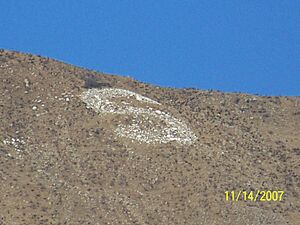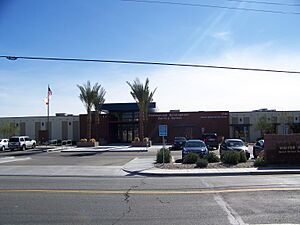San Jacinto Valley facts for kids
The San Jacinto Valley is a beautiful valley located in Riverside County, in sunny Southern California. It's part of a larger area called the Inland Empire. The valley sits at the bottom of the San Jacinto Mountains to the east and the Santa Rosa Hills to the south. To the north is the San Gorgonio Pass.
The valley is about 1,500 feet (460 m) above sea level. Its highest spots are in the hills south of Hemet and on the western slopes of the San Jacinto Mountains. Two main cities call this valley home: Hemet and San Jacinto. There are also several smaller communities here. Almost 170,000 people live in the valley, with over 130,000 in Hemet and San Jacinto alone.
The famous story and play "Ramona" is set in this valley. Author Helen Hunt Jackson wrote it after visiting the area in the 1880s. The valley was once known for its farms, but now it has grown into a more developed area.
Contents
History of the Valley
The first people to live in the San Jacinto Valley arrived thousands of years ago. Later, the Serrano and Cahuilla people settled here. Their villages were often found near streams and springs. These early people hunted small animals and gathered food like acorns to survive. Today, the Soboba Indian Reservation, just east of San Jacinto, is home to the descendants of some of these groups.
The first Spanish explorers came to the San Jacinto Valley in the early 1770s. In 1774 and again in 1775, Colonel Juan Bautista de Anza led two trips from Mexico. They crossed the Colorado River at Yuma, went through the Borrego Desert, and then up Coyote Canyon. For a few years, the San Jacinto Valley was an important stop on the main land route to California.
In the early 1800s, the area became a large cattle ranch for the Spanish Mission San Luis Rey, which is now in Oceanside. This land was known as Rancho San Jacinto. When the Mexican government closed the missions, the land was given to José Antonio Estudillo in 1842. This large piece of land eventually became the cities of San Jacinto and Hemet.
Cities in the Valley
The San Jacinto Valley has two main cities: Hemet and San Jacinto. Both cities have grown a lot since the 1980s. They are now one of the fastest-growing areas in California and Riverside County.
Hemet
Hemet covers about 27.7 square miles (72 km2) and has a population of 83,166 people. It was founded in 1887 and became a city on January 20, 1910. Hemet is home to most of the valley's population.
The city is famous for the Ramona Bowl, where "Ramona" is performed. This outdoor play is the official state play of California. Hemet is located at the southern end of the valley. You can also find the Western Science Center and Diamond Valley Lake here. Hemet is known as a Tree City USA by the National Arbor Day Foundation. It also has the only hospital in the valley.
San Jacinto
San Jacinto covers about 25.3 square miles (66 km2) of land. Its population was about 48,146 in 2018. The city was named after Saint Hyacinth and is at the north end of the valley. San Jacinto was founded in 1870 and became a city on April 9, 1888. This makes it one of the oldest cities in Riverside County.
The city is home to Mt. San Jacinto College. This community college has served the valley and the Inland Empire since 1965. San Jacinto is also planned to be the end point for the Mid County Parkway. This new road will connect to I-215 in Perris.
Smaller Communities
Besides the main cities, several smaller communities are part of the San Jacinto Valley.
East Hemet
East Hemet is a community just east of Hemet. In 2010, it had 17,418 people. It covers about 3.2 square miles (8.3 km2) of land. East Hemet is located between Hemet and Valle Vista.
Homeland
Homeland is a community about 8 miles (13 km) west of Hemet. It had 5,969 people in 2010.
Valle Vista
Valle Vista is a community east of Hemet. It stretches south to Bautista Canyon and east to the base of the San Jacinto Mountains. Valle Vista covers about 3.4 square miles (8.8 km2) of land. In 2010, its population was 11,036.
Fairview Avenue, which runs through Valle Vista, is part of the old Juan Bautista de Anza National Historic Trail. This historic trail was one of the first land routes to California.
Winchester
Winchester is a community in Riverside County. In 2010, it had 2,534 people. Winchester is mostly rural with many ranches and local businesses. It was once home to the Winchester Cheese Company.
Education
The San Jacinto Valley has several school districts and a college.
School Districts
Hemet Unified School District
The Hemet Unified School District serves 22,512 students. It covers the Hemet area and communities like Aguanga and Anza. The district has 15 elementary schools, 5 middle schools, 5 high schools, and one preschool. It also offers 3 alternative schools. The main office is in Hemet.
San Jacinto Unified School District
The San Jacinto Unified School District serves about 9,000 students in San Jacinto. It has five elementary schools, two middle schools, and two high schools. The district also offers Head Start and preschool programs.
Colleges
The valley is served by Mt. San Jacinto College. This community college has been helping students since 1963. The college district was created in 1962 by people in Banning, Beaumont, Hemet, and San Jacinto. Classes started in 1963 in rented buildings. The San Jacinto Campus opened in 1965 and has grown a lot since then.
In 1975, more areas joined the college district, making it 1,700 square miles (4,400 km2) large. The San Jacinto Campus is planning to rebuild and grow over the next 15 to 20 years to serve 12,000 to 15,000 students. New buildings like the Alice P. Cutting Business & Technology Center (opened 1993) and a music building (opened 1995) have added modern learning spaces.
Museums
The San Jacinto Valley has several museums where you can learn about its history and natural science.
Estudillo Mansion Museum
The Estudillo Mansion Museum is in San Jacinto. It's located near Seventh Street.
Hemet Museum
The Hemet Museum is in downtown Hemet, inside the old Hemet Depot building. It shows exhibits about the area's history, Native American artifacts found nearby, and the valley's farming past. You can also see exhibits about the "Ramona" play and railroads.
Ramona Bowl Museum
The Ramona Bowl Museum is located at the Ramona Bowl, where the Ramona Outdoor Play takes place.
Ryan Field Museum
The Ryan Field Museum is at Hemet-Ryan Field in Hemet.
San Jacinto Museum
The San Jacinto Museum was started in 1939 by local citizens. It has exhibits on the natural and human history of San Jacinto and the surrounding areas. You can see local Native American items, things from pioneer families, and information about the community's businesses. Special exhibits include a record-breaking 1937 Soviet flight that landed in San Jacinto. The museum also has many old photos and items for people doing research.
Western Science Center
The Western Science Center is in southern Hemet. It features amazing exhibits of Ice Age animals. You can see 'Max', the largest mastodon found in the western United States, and 'Xena', a Columbian Mammoth. The museum also has special exhibits that change over time. It once featured an exhibit about the music in Walt Disney films. The museum also has an Immersion Theater with a 270-degree screen for an amazing viewing experience.
Winchester Patterson House
The Patterson House was built in 1891 and is made of brick. It is the oldest private home still standing in Winchester. The Patterson family moved to the area in 1883. They were very important in helping the community grow.
John Patterson was a key figure in the community. He was:
- A major land owner
- A general store owner
- A blacksmith and tinsmith
- A board member of the first creamery
- Part owner of the local brick works
- A farmer
- A board member of the San Jacinto and Pleasant Valley Irrigation District
The Patterson House is now a museum in Winchester. It is located just off Highway 79. Some visitors have reported strange happenings like knocking sounds or objects moving. Some people believe it's the spirit of Lloyd Patterson, who passed away in the house a long time ago.
Transportation
The San Jacinto Valley has state highways and an airport, along with public transportation.
State Highways
Two state highways pass through the valley: SR 74 and SR 79.
SR 74 starts in San Juan Capistrano and travels through mountains before reaching Lake Elsinore and Perris. It enters the San Jacinto Valley as Florida Avenue. At the eastern end of the valley, it goes through the San Jacinto Mountains and ends in Palm Desert.
SR 79 begins near Alpine in San Diego County. It goes north to Julian and Warner Springs before reaching Temecula in Riverside County. SR 79 also enters the valley. In Hemet, it shares the road with SR 74 (Florida Avenue) for a few miles. Then it heads north through San Jacinto, following several streets before ending in Beaumont at Interstate 10.
Airports
The main airport in the San Jacinto Valley is Hemet-Ryan Airport. Another airport, French Valley Airport, is about 15 miles (24 km) southwest in French Valley.
Hemet-Ryan Airport is about 3 miles (5 km) southwest of central Hemet. It's a general aviation airport, meaning it's used by smaller planes. It sits at 1,512 feet (461 m) above sea level. The airport has two runways, both with asphalt surfaces. There are 236 airplanes based here, including single-engine planes, multi-engine planes, a jet, and helicopters. The airport is also home to a very busy California Department of Forestry and Fire Protection base for firefighting planes and helicopters. Riverside County owns and operates the airport.
Public Transportation
Public transportation in the valley is provided by the Riverside Transit Agency (RTA). There is also an Amtrak bus stop in Hemet. The bus system connects the valley to other cities in the Inland Empire, like Riverside, Temecula, Menifee, Banning, and Corona. It also connects to Escondido in San Diego County.
Metrolink train service is being planned for two stations in the area. One would be on the west side of Hemet, and another in downtown Hemet.




